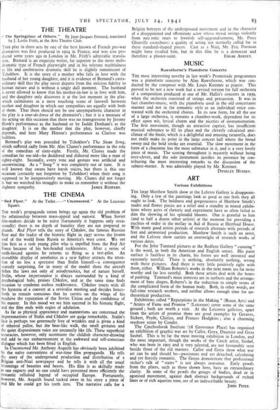Various Exhibitions
ART
THE large Matthew Smith show at the Lefevrc Gallery is disappoint- ing. Only a few of the paintings look as good as one feels they all ought to look. The boldness and gorgeousness of Matthew Smith's nudes and flower pieces are a relief and a standby in mixed exhibi- tions where acres of rhetoric and experiment have so often failed to dim the showing of his splendid blooms. One is grateful to him (and to half a dozen other artists) at the moment for providing a nucleus of order in the mellay in Aid of Russia at Hertford House. With many good artists periods of research alternate with periods of free and unworried production. Matthew Smith is such an artist, and the Lefevre show carries an overweight of research works of various dates.
For the John Tunnard pictures at the Redfern Gallery " cunning " is the word, in both the American and English senses. His paint surface is faultless in its charm, his forms are well invented and extremely tasteful. There is nothing, absolutely nothing, wrong with these pictures. And there is very little positively right with them, either. William Roberts's works in the next room are far more worthy and far less tasteful. Both these artists deal with the bones of painting. Tunnard's main interests are in surfaces and the arrange- ment of bare shapes, Roberts's in the reduction to simple terms of the complicated form of the human body. Both, in other words, are full-time research workers, and neither allows enough time for un- theoretical production.
Exhibitions called " Reputations in the Making " (Beaux Arts) and " Artists of Fame and Promise " (Leicester) cover some of the same ground; are worth a visit. At the Leicester galleries, apart from th artists of promise there are good examples by Greaves, Sicker; Pryde, Chirico, and Frances Hodgkins ; also a charming seashore scene by Conder.
The Czechoslovak Institute (i8 Grosvenor Place) has organised an exhibition of graphic war art by Callot, Goya, Daumier and Geza Szobel. This is by far the most moving exhibition in London, and the most important, though the works of the Czech artist, Szobel, who was born in 1905 and is very talented, are not favourably seen beside those of the old masters. Callot and Goya show what war art can be and should be—passionate and yet detached, calculating and yet fiercely romantic. The Goyas demonstrate that professional etcher's talk of " states " is not always nonsense. Early proofs from the plates, such as those shown here, have an extraordinary clarity. In some of the proofs the groups of bodies, dead or in agonised movement, against dark abstract backgrounds of etched lines or of rich aquatint tone, are of an indescribable beauty.
JOHN PIPER.


























 Previous page
Previous page